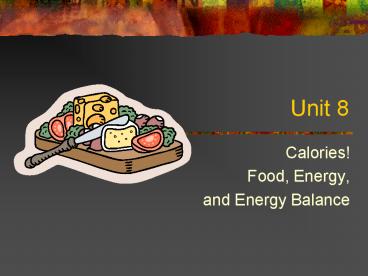Calories - PowerPoint PPT Presentation
1 / 19
Title:
Calories
Description:
Dietary thermogenesis. Energy used to chemically process foods (process gives off heat) ... Dietary thermogenesis 195. TOTAL = 2145 calories. Where is the ... – PowerPoint PPT presentation
Number of Views:1875
Avg rating:3.0/5.0
Title: Calories
1
Unit 8
- Calories!
- Food, Energy,
- and Energy Balance
2
Calories are a unit of measure
- Used to express the amount of energy produced by
foods in the form of heat - Calories are actually kilocalories or kcals
- the amount of energy needed to raise the
temperature of kilogram of water one degree
Celsius. - 1 kcal or calorie 1 kilojoule
3
How do they determine the caloric value of foods?
- Bomb calorimeter
- Burn the food entirely and measure the increase
in temperature of the surrounding water - Heat released by the food is approximately the
same as the energy it supplies for the body
4
The body needs energy
- Fuel muscular activity
- Growth
- Tissue repair and maintenance
- Chemically process nutrients
- Maintain body temperature
- Many other uses
5
Types of energy use
- Basal Metabolism
- Energy required to maintain normal body functions
while at rest - Physical activity
- Energy needed for muscular work
- Dietary thermogenesis
- Energy used to chemically process foods (process
gives off heat)
6
Basal Metabolism
- Measure of the energy used when a body is in a
state of complete rest - Estimate your basal metabolic rate
- Men body weight (lbs) times 11
- Women body weight (lbs) times 10
- 170 lb man X 11 1870 cals/day
- 135 lb woman X 10 1350 cals/day
7
Physical Activity
- Amount spent depends on activity level
- Inactive 30 of basal metabolism calories
- Average 50 of basal metabolism calories
- Active 75 of basal metabolism calories
- Example if basal metabolism 1500
- Inactive person 1500 X .30 450 calories
- Average person 1500 X .50 750 calories
- Active person 1500 X .75 1125 calories
8
Activity level often overestimated
- Dont count time getting ready or breaks or
timeouts
9
Dietary thermogenesis
- Digesting food
- Absorbing food
- Utilizing nutrients
- Transporting nutrients to cells
- Energy escapes as heat
- Estimated at 10 of total calories
10
Adding it all up
- Total daily need for calories
- Basal metabolic rate 1500
- Activity (inactive) 450
- Dietary thermogenesis 195
- TOTAL 2145 calories
11
Where is the energy in foods?
- Carbohydrates 4 cal/gram
- Proteins 4 cal/gram
- Fats 9 cal/gram
12
Which food has the most calories?
- 1 Tablespoon margarine
- 1 Tablespoon sugar
- 1 Tablespoon steak
13
Which food has the most calories?
- 205 calories
- 420 calories
- 118 calories
- Half-cup peanuts
- Medium-sized potato
- One cup rice
14
Which food has the most calories?
- 205 calories
- 420 calories
- 118 calories
- Half-cup peanuts
- Medium-sized potato
- One cup rice
15
Most foods are a mixture
- Quarter- pound hamburger
- 32 gm protein
- 39 gm carbohydrate
- 32 gm fat
- Total calories 576
16
How is caloric intake regulated by the body?
- Hunger unpleasant physical and psychological
sensations that lead people to acquire and ingest
food - Satiety a feeling of fullness or of having had
enough to eat - Appetite the desire to eat a pleasant sensation
that is aroused by thoughts of the taste and
enjoyment of food
17
Energy Balance
- Energy intake energy need
- Weight remains stable
18
Negative Energy Balance
- Energy intake is less than energy need
- Weight loss
19
Positive Energy Balance
- Energy intake is more than energy need
- Weight gain

























![[READ] The Power Foods Diet The Breakthrough Plan That Traps Tames and Burns Calories for Easy and PowerPoint PPT Presentation](https://s3.amazonaws.com/images.powershow.com/10149987.th0.jpg?_=20241005023)





![[DOWNLOAD]⚡️PDF✔️ Now Eat This!: 150 of America's Favorite Comfort Foods, All Under 350 Calories PowerPoint PPT Presentation](https://s3.amazonaws.com/images.powershow.com/10068408.th0.jpg?_=202407010610)